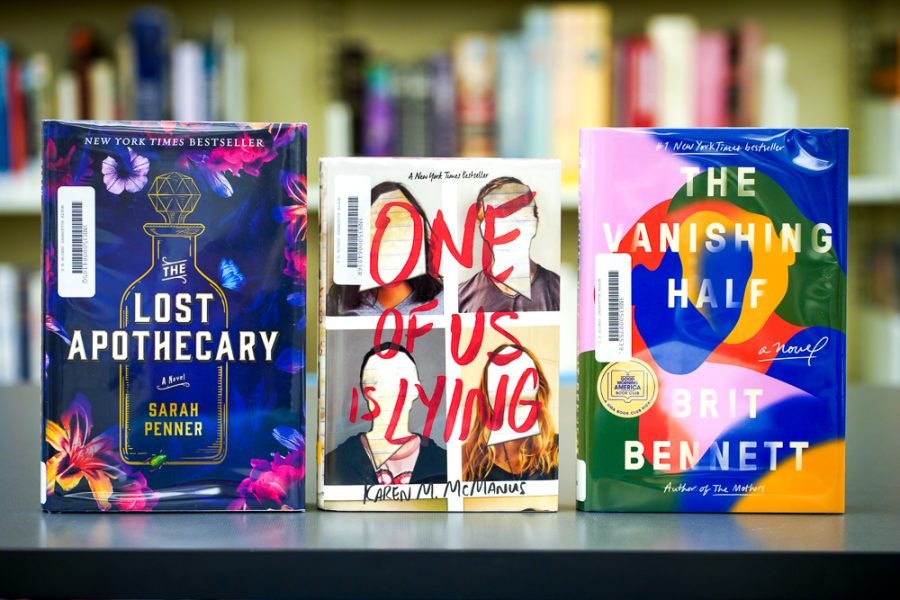Turn the Page
A review of three contemporary novels
Popularity on social media has brought attention to these books, but the stories themselves are what truly draw readers in.
March 28, 2022
The following three books are similar in a few ways–they are New York Times bestsellers, recommended on YouTube by numerous creators, and are in the library, available for your reading pleasure at this very moment. If my descriptions or opinions of any of these books interest you, I urge you to read them for yourself and form your own opinion.
The Vanishing Half by Brit Bennett ★★★★
This book covers a set of identical twins, Desiree and Stella, from a small fictional town called Mallard, Louisiana, and their lives from the 1940s to 90s. The town is run based on colorism that encourages lighter black skin through generations. After running away from the town, each twin eventually goes their separate way. One rejects the hometown’s standards and marries a fully Black man and the other pretends to be white.
Out of these three, this novel was the hardest for me to get into. I still am unsure why, though it may just be because of how much it jumps around to different narratives. The book is entirely third-person omniscient, which I didn’t feel very used to at the beginning, but Bennet did it in such a way that manages to foster a genuine personality and mindset for each character.
As soon as the story of Stella, the sister who led a secret life of pretending to be white, began, I couldn’t put the book down. Despite disagreeing with how she threw away such a vital part of her identity, I understood how the trauma she faced pushed her to do this, and I could still appreciate how her story was told. It was so interesting to see how she carries out her fake life, as well as the way that her family, who is unaware of her past and identity, perceives her anxiety of being found out.
Bennett fits in numerous concepts and executes them in a vulnerable yet interesting way, including explicit and implicit racism, internalized racism, colorism, the transgender experience in the twentieth century, domestic abuse, trauma, and identity as a whole. I was especially impressed by how well she was able to tie each of these themes together because it would have been much easier to just implement them separately.
Similarly, Bennett connects the women through a beautifully written storyline despite the fact that, for most of the book, their lives are entirely separate and they know nothing of the others’ location. This furthers the idea of familial ties falling apart.
Despite the fact that this novel took a bit longer to grab my interest, I fell in love with the themes that Bennett so perfectly implemented in her gorgeous storytelling, and in my view, it beats out the other two stories by a long shot simply because of its quality and complexity.
The Lost Apothecary by Sarah Penner ★★★
Much like the rest of the picks on this list, I was immediately intrigued by the synopsis of this tale. It bounces back and forth between narratives in the late 1700s and the present day, all relating to an apothecary that sells poisons to women to carry out revenge against the cheating and deceitful men in their lives.
Nella, the owner of the apothecary, deals with the trauma of her past all while facing the guilt that she faces from being indirectly at fault for innumerable deaths that she accounts for in her register, all in hopes of keeping these women’s legacies alive long after they are gone. Caroline, a former history major, travels to London alone after finding out her husband has lied to her, and slowly begins to unravel the lost apothecary, largely through chance but also by way of research and assistance from new friends.
The unique connection between these two women, despite the centuries between them, felt very special to me. Though Caroline’s eagerness about random historical information probably comes off as boring to most readers, including me, I relate to her passion for what she loves. However, Penner carries this out a bit blandly, which bored me at times.
My favorite part of this novel was the stories of the women who came to the apothecary for help. The description of betrayal by someone you trust cuts deep, even when it’s not entirely relatable to everyone. Penner did this well, depicting the roots of the apothecary in a harrowing and well-written way.
One of Us Is Lying by Karen M. McManus ★★★★
This book is the tale of a detention where the students have been framed into getting in trouble, and only four of the five students walk out alive. Simon Kelleher, the creator of a gossip app called “About That,” dies suddenly after taking a sip of water. The police and community members are quick to jump to conclusions, and because the way that Simon died becomes increasingly suspicious, everyone involved knows that someone is lying.
For about half of this read, I had a three-star rating in mind. It was so incredibly generic, and openly admitted to its characters fitting inside boxes like “the criminal,” “the nerd,” and “the jock.” I was overwhelmed by this at first, but I eventually came to the conclusion that this was likely how the author wanted to frame the story and I was wrapped up in comparing this strategy to that of books with authors who aim to be different from everyone else (or authors that come off this way on accident).
That’s not to say that I would criticize the alternative, in fact, most books that fit under such a category end up being five-star reads for me. But this comparison hindered a perspective that I later developed: the stereotypical standards are often how we place people into cliques and boxes, especially in high school, and this novel knowingly works to unravel the nuances of individuality, rather than maintaining such toxic expectations.
One of Us Is Lying was written in quite a simple way, making this novel easy to breeze through. I felt that this writing style was extremely necessary to this type of story because getting through it quickly added to the experience of learning new twists with every turn of the page.
Though I predicted the culprit quite early on, these plot twists, in addition to the story’s deeper meaning that I gradually caught up to, were what eventually pushed me from a three-star to a four-star rating.













